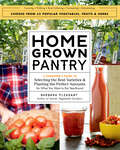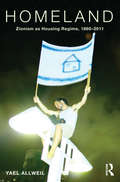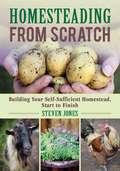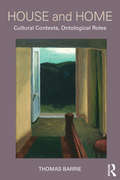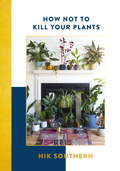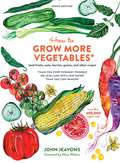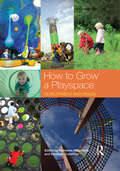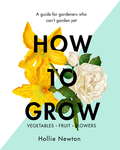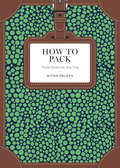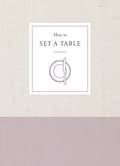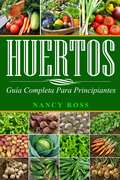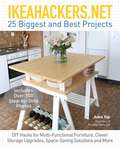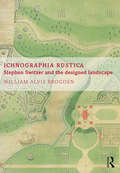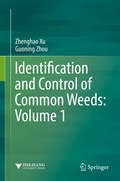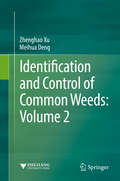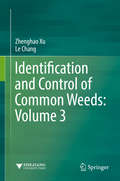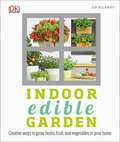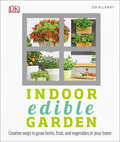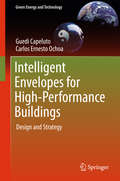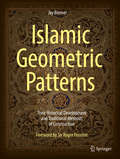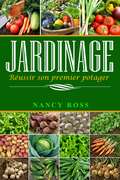- Table View
- List View
Homegrown Pantry: A Gardener's Guide to Selecting the Best Varieties & Planting the Perfect Amounts for What You Want to Eat Year-Round
by Barbara PleasantNow that you&’ve mastered gardening basics, you want to enjoy your bounty year-round, right? Homegrown Pantry picks up where beginning gardening books leave off, with in-depth profiles of the 55 most popular crops — including beans, beets, squash, tomatoes, and much more — to keep your pantry stocked throughout the year. Each vegetable profile highlights how many plants to grow for a year&’s worth of eating, and which storage methods work best for specific varieties. Author Barbara Pleasant culls tips from decades of her own gardening experience and from growers across North America to offer planting, care, and harvesting refreshers for every region and each vegetable. Foreword INDIES Silver Award Winner GWA Media Awards Silver Award Winner
Homeland: Zionism as Housing Regime, 1860–2011 (Planning, History and Environment Series)
by Yael AllweilOn 29 March 2016 the New York based online journal, Realty Today reported ‘Israel is facing a housing crisis with …[the] home inventory lacking 100,000 apartments… House prices, which have more than doubled in less than a decade, resulted in a mass protest back in 2011’. As Yael Allweil reveals in her fascinating book, housing has played a pivotal role in the history of nationalism and nation building in Israel-Palestine. She adopts the concept of ‘homeland’ to highlight how land and housing are central to both Zionism and Palestinian nationalism, and how the history of Zionist and Palestinian national housing have been inseparably intertwined from the introduction of the Ottoman Land Code in 1858 to the present day. Following the Introduction, Part I, ‘Historiographies of Land Reform and Nationalism’, discusses the formation of nationalism as the direct result of the Ottoman land code of 1858. Part II, ‘Housing as Proto-Nationalism’ focuses on housing as the means to claim rights over the homeland. Part III, ‘Housing and Nation-Building in the Age of State Sovereignty’, explores the effects of statehood on national housing across several strata of Israeli society. The Afterword discusses housing as the quintessential object of agonistic conflict in Israel-Palestine, around which the Israeli polity is formed and reformed.
Homesteading From Scratch: Building Your Self-Sufficient Homestead, Start to Finish
by Steven JonesHomesteading From Scratch is for people who want to do things differently. The type of people who want to eat real food, grow herbs, make cheese, raise baby animals, hunt mushrooms, pick blackberries, unschool their children, can jelly, ferment kraut, farm organically, connect to nature, live intentionally, and more.Guiding readers from desire to full-blown off-the-grid living-and everything in between-this book covers farming, animal husbandry, food preparation, homeschooling, fiber arts, and even marketing. It provides inspiration from other homesteaders, with operations from small to large, who have made a go of it, outlining their successes and failures throughout the process. It helps to democratize the homesteading movement, by providing "ins” for nearly every level of dedication, from the container gardener to full-time farmers. It provides the knowledge necessary to discover homesteading as a movement and as a lifestyle.Inspired by From Scratch magazine, an online publication devoted to homesteading and intentional living, this book provides readers with continued support and community for information and resources online. This book serves as a reference, as well as a cheerleader, for those who want a bit more control and responsibility over where their food comes from, the things they consume, and how they live their lives.
Horta para iniciantes - manual completo
by Rosana Vargas Nancy RossO capítulo 1 ensina como selecionar as ferramentas adequadas. Impossível iniciar o cultivo de horta sem ter o material apropriado em ordem. É necessário tê-las em mão antes de começar o cultivo e garantir as melhores chances de sucesso. Depois é importante definir local adequado para que o crescimento e o desenvolvimento da horta ocorra conforme desejado. O capítulo 2 traz aspectos importantes a serem considerados no momento de selecionar o local apropriado para a horta.
House and Home: Cultural Contexts, Ontological Roles
by Thomas BarrieHouse and home are words routinely used to describe where and how one lives. This book challenges predominant definitions and argues that domesticity fundamentally satisfies the human need to create and inhabit a defined place in the world. Consequently, house and home have performed numerous cultural and ontological roles, and have been assiduously represented in scripture, literature, art, and philosophy. This book presents how the search for home in an unpredictable world led people to create myths about the origins of architecture, houses for their gods, and house tombs for eternal life. Turning to more recent topics, it discusses how writers often used simple huts as a means to address the essentials of existence; modernist architects envisioned the capacity of house and home to improve society; and the suburban house was positioned as a superior setting for culture and family. Throughout the book, house and home are critically examined to illustrate the perennial role and capacity of architecture to articulate the human condition, position it more meaningfully in the world, and assist in our collective homecoming.
How Not To Kill Your Plants
by Nik SouthernHands up if you've killed a plant? Yep, me too. It's no secret that we've all become plant obsessed, but do we really understand how to look after them? I am not a Professor of Botany, but having run my florist and plant shop, Grace & Thorn, since 2011 I've learnt a few things along the way. HOW NOT TO KILL YOUR PLANTS is about taking the hocus-pocus out of plants and flowers and enabling you to understand a plant's needs in order to know where to place and how to style them, but most importantly how to keep them alive.I get asked every type of question you can imagine and I have written this book to answer them. Watering can down, it's time to go back to the roots.Keep it green.Nik x(AKA The Agony Plant)
How Not To Kill Your Plants: Know, Grow And Style
by Nik SouthernHands up if you've killed a plant? Yep, me too. It's no secret that we've all become plant obsessed, but do we really understand how to look after them? I am not a Professor of Botany, but having run my florist and plant shop, Grace & Thorn, since 2011 I've learnt a few things along the way. HOW NOT TO KILL YOUR PLANTS is about taking the hocus-pocus out of plants and flowers and enabling you to understand a plant's needs in order to know where to place and how to style them, but most importantly how to keep them alive.I get asked every type of question you can imagine and I have written this book to answer them. Watering can down, it's time to go back to the roots.Keep it green.Nik x(AKA The Agony Plant)
How to Grow More Vegetables, Ninth Edition: (and Fruits, Nuts, Berries, Grains, and Other Crops) Than You Ever Thought Possible on Less Land with Less Water Than You Can Imagine
by John JeavonsThe world's leading resource on biointensive, sustainable, high-yield organic gardening is thoroughly updated throughout, with new sections on using 12 percent less water and increasing compost power. Long before it was a trend, How to Grow More Vegetables brought backyard ecosystems to life for the home gardener by demonstrating sustainable growing methods for spectacular organic produce on a small but intensive scale. How to Grow More Vegetables has become the go-to reference for food growers at every level, whether home gardeners dedicated to nurturing backyard edibles with minimal water in maximum harmony with nature's cycles, or a small-scale commercial producer interested in optimizing soil fertility and increasing plant productivity. In the ninth edition, author John Jeavons has revised and updated each chapter, including new sections on using less water and increasing compost power.
How to Grow a Playspace: Development and Design
by Katherine Masiulanis Elizabeth CumminsHow to Grow a Playspace takes you through a global perspective of the different stages of child development and the environments that engage children in play around the world. From the urbanity of Mumbai; to rainbow nets in Japan; nature play in Denmark; recycling waste in Peru; community building in Uganda; play streets in London; and gardens of peace in Palestine, it proves that no matter where play occurs, it is ubiquitous in its resourcefulness, imagination and effect. Written by international leaders in the field of play including academics, designers and playworkers, How to Grow A Playspace discusses contemporary issues around children and play, such as risk benefit in play, creativity and technology, insights into children’s thinking, social inclusion and what makes a city child-friendly. With its own ‘Potting Shed’, this text is also a practical guide to support playspace projects with advice on teams, budgets, community engagement, maintenance and standards. How to Grow a Playspace is a comprehensive ‘go-to’ guide for anyone interested or involved in children’s play and playspaces.
How to Grow: A guide for gardeners who can't garden yet
by Hollie Newton'I like that you call brussel sprouts w*nkers' - DIANE MORGAN/PHILOMENA CUNK'Your book was our bible all summer' - PEARL LOWE'As a gardening beginner/twit I'm a huge fan' - KEELEY HAWESThis is the gardening book reimagined for a new generation. A book for people who want to learn how to grow things, but haven't got a clue where to start.With the average person now spending an enormous 8 hours and 41 minutes in front of a screen every day, gardening is an easy way to escape for half an hour. Whether on a rented balcony or a sunny kitchen windowsill, it turns out growing something with your own two hands can make you feel better. Which is where HOW TO GROW comes in. Irreverent and inspiring, this book will equip you with all the know-how and confidence you need to take your first steps into a lifelong gardening love affair - trowel in one hand, drink in the other.From growing your first wonky courgette to completely transforming a shady patio garden, in HOW TO GROW, self-taught gardener Hollie Newton divulges all the secrets she's discovered over the past few years as she's journeyed from gardening novice to vegetable-grower-extraordinaire - all from her pint-sized London garden. With chapters on easy-to-grow veg, fruit, herbs, salad and flowers (along with plenty of tried-and-tested guidance to keeping those plants alive, and delicious recipes to make the most of your haul), you'll also learn everything from the basics of planning your garden to stylish design ideas.Focusing on small and urban spaces and including beautiful photography throughout, this is practical advice for a whole new generation of gardeners.
How to Grow: A guide for gardeners who can't garden yet
by Hollie NewtonThis is the gardening book reimagined for a new generation. A book for people who want to learn how to grow things, but haven't got a clue where to start.With the average person now spending an enormous 8 hours and 41 minutes in front of a screen every day, gardening is an easy way to escape for half an hour. Whether on a rented balcony or a sunny kitchen windowsill, it turns out growing something with your own two hands can make you feel better. Which is where HOW TO GROW comes in. Irreverent and inspiring, this book will equip you with all the know-how and confidence you need to take your first steps into a lifelong gardening love affair - trowel in one hand, drink in the other.From growing your first wonky courgette to completely transforming a shady patio garden, in HOW TO GROW, self-taught gardener Hollie Newton divulges all the secrets she's discovered over the past few years as she's journeyed from gardening novice to vegetable-grower-extraordinaire - all from her pint-sized London garden. With chapters on easy-to-grow veg, fruit, herbs, salad and flowers (along with plenty of tried-and-tested guidance to keeping those plants alive, and delicious recipes to make the most of your haul), you'll also learn everything from the basics of planning your garden to stylish design ideas.Focusing on small and urban spaces and including beautiful photography throughout, this is practical advice for a whole new generation of gardeners.
How to Pack: Travel Smart for Any Trip
by Hitha PalepuIt’s time to pack perfect. Every trip, every time. Your journey starts here. When you travel, the journey is just as important as the destination—and packing is the first step. In How to Pack, Hitha Palepu, a former consultant who has traveled more than 500,000 cumulative miles around the world, shows that what and how you pack are who you are. Confidence and comfort inspire success upon arrival, whether you’re exploring a new city, hoping to nail a job interview, or relaxing on a beach. In How to Pack, you’ll learn about: · Power Pieces vs. Fantasy Pieces: How clothing earns its place in your suitcase · The Accessory Math Secret: The precise formula for all you need to finish off your outfits · Folding versus Rolling: What’s right for which items · Globetrotter Gorgeous: Editing your beauty routine while still looking great · The Packing Timeline: How to avoid “I’m forgetting something” syndrome · Pack Perfect Lists: Samples and blanks for any kind of trip
How to Set a Table: Inspiration, Ideas, and Etiquette for Hosting Friends and Family
by PotterThis hip, fabric-covered guide includes creative ways to style a table--whether for a sit-down dinner, cocktail party, brunch buffet, picnic in the park, and other fun get-togethersWhether you live in a small apartment or sprawling suburban kitchen, How to Set a Table features stylish, modern ideas for welcoming family and friends in your home. This gift book, wrapped in a pretty, printed fabric, serves as a practical step-by-step guide to entertaining--with extra information on etiquette, place setting basics, centerpieces, mixing and matching, essential glassware, and napkin folds. With unexpected ideas for using all the great tableware you can find at flea markets, chain stores, or around the house, How to Set a Table updates a classic topic for a new generation of hosts.
Huertos: Guía completa para principiantes
by Nancy Ross J. I. Fernandez¿Quieres aprender a cultivar un huerto de frutales espectacular? Si quieres saber cuáles son las mejores opciones en cuanto a verduras que puedes cultivar o aprender a mantenerlas en buenas condiciones durante todo el año, este libro es la ayuda que necesitas. Encontrarás todo esto en el libro: Herramientas adecuadas, huertos caseros, huertos en tu comunidad, pasos para comenzar, las mejores verduras que puedes cultivar, mantenerlas en perfectas condiciones durante todo el año, los beneficios de un huerto y mucho más. Aprenderás a cultivar maíz, judías, tomates, guisantes, pimientos y mas!
IKEAHACKERS.NET 25 Biggest and Best Projects: DIY Hacks for Multi-Functional Furniture, Clever Storage Upgrades, Space-Saving Solutions and More
by Jules YapThe ingenious team at IkeaHackers.net show you how to transform affordable IKEA products into creative new furniture and more!Jules Yap and the contributors to her wildly popular website IkeaHackers.net show you how to transform affordable IKEA® products into creative new furniture and more. With clear instructions and easy-to-follow photos, you&’re sure to have fun building these exciting hacks, including: • Kitchen Island• Dollhouse• Vanity• Built-In Home Office• Mudroom Bench
Ichnographia Rustica: Stephen Switzer and the designed landscape
by William Alvis BrogdenOne of the most significant occurrences in the history of design was the creation of the English Landscape Garden. Accounts of its genesis…the surprising structural change from the formal to a seeming informal are numerous. But none has ever been quite convincing and none satisfactorily placed the contributions of Stephen Switzer. Unlike his contemporaries, Switzer - an 18th century author of books on gardening and agricultural improvement - grasped a quite new principle: that the fashionable pursuit of great gardens should be "rural and extensive", rather than merely the ornamentation of a particular part of an estate. Switzer saw that a whole estate could be enjoyed as an aesthetic experience, and by the process of improving its value, could increase wealth. By encouraging improvers to see the garden in his enlarged sense, he opened up the adjoining countryside, the landscape, and made the whole a subject of unified design. Some few followed his advice immediately, such as Bathurst at Cirencester. But it took some time for his ideas to become generally accepted. Could this vision, and its working out in practice between 1710 and 1740 be the very reason for such changes? 300 years after the first volume of his writings began to be published; this book offers a timely critical examination of lessons learned and Switzer’s roles. In major influential early works at Castle Howard and Blenheim, and later the more "minor" works such as Spy Park, Leeswood or Rhual, the relationships between these designs and his writings is demonstrated. In doing so, it makes possible major reassessment of the developments, and thus our attitudes to well-known works. It provides an explanation of how he, and his colleagues and contemporaries first made what he had called Ichnographia Rustica, or more familiarly Modern Gardening from the mid-1740s, land later landscape gardens. It reveals an exceptional innovator, who by transforming the philosophical way in which nature was viewed, integrated good design with good farming and horticultural practice for the first time. It raises the issue of the cleavage in thought of the later 18th century, essentially whether the ferme ornee as the mixture of utile and dulci was the perfect designed landscape, or whether this was the enlarged garden with features of "unadorned nature"? The book discusses these considerable and continuing contrary influences on later work, and suggests Switzer has many lessons for how contemporary landscape and garden design ought be perceived and practised.
Identification and Control of Common Weeds: Volume 1
by Zhenghao Xu Guoning ZhouThis book introduces readers to nearly 600 common weeds. In addition to essential information, each chapter includes photos for a specific type of weed to show its morphology in different growth periods, such as seedling, root, flower, fruit, and mature plant. The book also discusses control measures, including agricultural, chemical, physical, biological, and comprehensive methods. The Volume1 mainly focuses on 126 species of grass weeds and 34 species of sedge weeds. With the development of society and economics, weeds have become a recurring problem. In particular, the exotic, invasive, and quarantine weeds have spread dramatically and rapidly. On the other hand, many people, even those who are engaged in weed control, do not (or cannot) distinguish between weeds. Thus there is significant demand for illustrations of weed morphologies, as well as information on their control measures. This book offers a valuable, practical guide for all those working in the fields of crop cultivation, plant protection and quarantine management.
Identification and Control of Common Weeds: Volume 2
by Zhenghao Xu Meihua DengThis book introduces readers to nearly 600 common weeds. In addition to essential information, each chapter includes photos for a specific type of weed to show its morphology in different growth periods, such as seedling, root, flower, fruit, and mature plant. The book also discusses control measures, including agricultural, chemical, physical, biological, and comprehensive methods. The Volume2 mainly focuses on fern and 216 species of weeds of magnoliids or dicotyledoneae. With the development of society and economics, weeds have become a recurring problem. In particular, the exotic, invasive, and quarantine weeds have spread dramatically and rapidly. On the other hand, many people, even those who are engaged in weed control, do not (or cannot) distinguish between weeds. Thus there is significant demand for illustrations of weed morphologies, as well as information on their control measures. This book offers a valuable, practical guide for all those working in the fields of crop cultivation, plant protection and quarantine management.
Identification and Control of Common Weeds: Volume 3
by Zhenghao Xu Le ChangThis book introduces readers to nearly 600 common weeds. In addition to essential information, each chapter includes photos for a specific type of weed to show its morphology in different growth periods, such as seedling, root, flower, fruit, and mature plant. The book also discusses control measures, including agricultural, chemical, physical, biological, and comprehensive methods. The Volume 3 mainly focuses on 252 Species of Dicotyledonous and Monocotyledonous Weeds along with 2 Species of Liverworts and Mosses. With the development of society and economics, weeds have become a recurring problem. In particular, the exotic, invasive, and quarantine weeds have spread dramatically and rapidly. On the other hand, many people, even those who are engaged in weed control, do not (or cannot) distinguish between weeds. Thus there is significant demand for illustrations of weed morphologies, as well as information on their control measures. This book offers a valuable, practical guide for all those working in the fields of crop cultivation, plant protection and quarantine management.
Indoor Edible Garden
by Janette Marshall Zia AllawayMake the most of your space, from balconies and windowsills to countertops, walls, and even ceilings, to grow herbs, vegetables, and flowers in your home that look amazing and taste even better. Featuring 28 innovative step-by-step projects, Indoor Edible Garden is a highly visual guide full of practical tips and stylish ideas for how to create edible indoor gardens using whatever space you have available. Use your space and light in clever ways, brightening your home with unique living decorations. Inspiring from the start, this book shows off its lush garden projects through beautiful design and full-color photographs. Reference more than 30 profiles of the top herbs, edible flowers, fruiting plants, and vegetables. Follow DIY project templates to grow your gardens into beautiful home decor. The step-by-step instructions include how to create a hanging chili and basil ball, how to grown your own tea leaves, how to sprout microgreens in cupcake liners, and more. Plus, this guide also includes straightforward explanations of scientific methods such as artificial lighting and hydroponics and key techniques for planting, drainage, and harvesting. Indoor Edible Garden helps create stunning and edible home decor so your living space will be fruitful--and beautiful--all year round.
Indoor Edible Garden: Creative Ways to Grow Herbs, Fruits, and Vegetables in Your Home
by Zia AllawayMake the most of your space, from balconies and windowsills to countertops, walls, and even ceilings, to grow herbs, vegetables, and flowers in your home that look amazing and taste even better.Featuring 28 innovative step-by-step projects, Indoor Edible Garden is a highly visual guide full of practical tips and stylish ideas for how to create edible indoor gardens using whatever space you have available. Use your space and light in clever ways, brightening your home with unique living decorations. Inspiring from the start, this book shows off its lush garden projects through beautiful design and full-color photographs.Reference more than 30 profiles of the top herbs, edible flowers, fruiting plants, and vegetables. Follow DIY project templates to grow your gardens into beautiful home decor. The step-by-step instructions include how to create a hanging chili and basil ball, how to grown your own tea leaves, how to sprout microgreens in cupcake liners, and more. Plus, this guide also includes straightforward explanations of scientific methods such as artificial lighting and hydroponics and key techniques for planting, drainage, and harvesting.Indoor Edible Garden helps create stunning and edible home decor so your living space will be fruitful—and beautiful—all year round.
Install Your Own Solar Panels: Designing and Installing a Photovoltaic System to Power Your Home
by Philip Schmidt Joseph BurdickLabor and related costs account for more than half of the price of the average home solar installation. But homeowners can save thousands of dollars with this user-friendly manual, which follows the same process professional contractors use. Through detailed directions and step-by-step photos, veteran solar installer Joseph Burdick and seasoned builder Philip Schmidt teach you how to determine the size, placement, and type of installation you’ll need. This comprehensive DIY guide covers everything from assembling rooftop racking or building a ground-mount structure to setting up the electrical connections and making a battery bank for off-grid systems.
Intelligent Envelopes for High-Performance Buildings
by Guedi Capeluto Carlos Ernesto OchoaThis book presents a series of significant methods and examples for the design of sustainable intelligent facades in a variety of contexts. Emphasis is placed on how intelligence has been applied for successful energy-saving efforts in the planning of building envelopes. Readers will find essential information on the core principles involved in designing, calculating and organizing intelligent facades according to the need for a new or retrofitted building. Not only are different materials and technologies considered, but also efficient ways to combine them according to user needs and other project-specific constraints. Illustrations, tables and graphs accompany the text, clarifying the concepts discussed. Architects, facade consultants and all those interested in and energy-saving measures and improved indoor comfort will find this book useful not only as an introduction to the subject but also as a guide to achieving more responsive building methods.
Islamic Geometric Patterns
by Jay BonnerThe main focus of this unique book is an in-depth examination of the polygonal technique; the primary method used by master artists of the past in creating Islamic geometric patterns. The author details the design methodology responsible for this all-but-lost art form and presents evidence for its use from the historical record, both of which are vital contributions to the understanding of this ornamental tradition. Additionally, the author examines the historical development of Islamic geometric patterns, the significance of geometric design within the broader context of Islamic ornament as a whole, the formative role that geometry plays throughout the Islamic ornamental arts (including calligraphy, the floral idiom, dome decoration, geometric patterns, and more), and the underexamined question of pattern classification. Featuring over 600 beautiful color images, Islamic Geometric Patterns: Their Historical Development and Traditional Methods of Con struction is a valuable addition to the literature of Islamic art, architecture and geometric patterns. This book is ideal for students and scholars of geometry, the history of mathematics, and the history of Islamic art, architecture, and culture. In addition, artists, designers, craftspeople, and architects will all find this book an exceptionally informative and useful asset in their fields. Jay Bonner is an architectural ornamentalist and unaffiliated scholar of Islamic geometric design. He received his MDes from the Royal College of Art in London (1983). He has contributed ornamental designs for many international architectural projects, including the expansion of both the al-Masjid al-Haram (Grand Mosque) in Mecca, and the al-Masjid an Nawabi (Prophet's Mosque) in Medina, as well the Tomb of Sheikh Hujwiri in Lahore, and the Ismaili Centre in London - to name but a few. He is committed to the revitalization of Islamic geometric design through the teaching of traditional methodological practices. To this end, in addition to publishing, Jay Bonner has lectured and taught design seminars at many universities and conferences in North America, Europe, North Africa and Asia.
Jardinage: Réussir son premier potager
by Nancy Ross Romain BoisnaultÉGALEMENT DISPONIBLE EN VERSION PAPIER ET EN VERSION AUDIO ! (=> also available in paperback and audio) Que vous souhaitiez découvrir les meilleurs légumes à cultiver ou apprendre comment les conserver toute l'année : ce livre est là pour vour aider ! Voici un aperçu de ce que vous aller découvrir... BIEN S'ÉQUIPER UN POTAGER À LA MAISON LE JARDIN COMMUNAUTAIRE COMMENCER SON POTAGER EN QUELQUES ÉTAPES LES MEILLEURS LÉGUMES À CULTIVER CONSERVER VOS LÉGUMES TOUTE L'ANNÉE LES BIENFAITS DU JARDINAGE ET BIEN PLUS ENCORE ! Voici les légumes que je vais vous présenter : MAÏS HARICOTS VERTS TOMATES POIS POIVRONS
